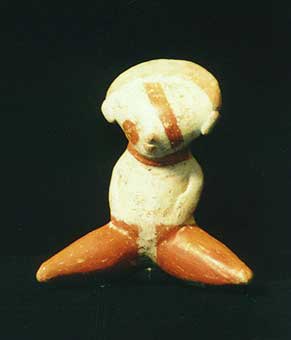Chinesco Style (Type C) Nayarit Terracotta Seated Figure, 300 BCE - 300 CE
Terracotta
4.75 x 5.125
PF.2922
In the Nayarit tradition, simple images such as this large seated female often had an underlying funerary symbolism, appropriate for their function as effigy figures in shaft tomb graves. This...
In the Nayarit tradition, simple images such as this large seated female often had an underlying funerary symbolism, appropriate for their function as effigy figures in shaft tomb graves. This figure has been depicted with a flat, rounded, almost heart-shaped face, and thin eye slits, traits, which characterize the Chinesco style that originated in South Western Nayarit. The touch of the ancient artisan is still felt here through the remnants of original paint, which mark the figure's face and head, distinguishing it from similar figures and giving it individual importance.
Towards the end of the pre-classic period in Ancient Meso-America, the regions of Colima, Nayarit, and Jalisco in Western Mexico became home to what has now been termed the shaft-tomb culture. These people built tombs consisting of shafts 10-60 feet deep with several avoid tombs branching either directly off of the main shaft at various levels, or connected to it by lateral tunnels. The burial offerings, which filled these tombs, have become our greatest link to this lost culture. The hollow pottery figures which were commonly placed in the tomb chambers show stylistic variations between regions, giving us glimpses into the cultural differences between these groups as well as the beliefs that they held in common.
Towards the end of the pre-classic period in Ancient Meso-America, the regions of Colima, Nayarit, and Jalisco in Western Mexico became home to what has now been termed the shaft-tomb culture. These people built tombs consisting of shafts 10-60 feet deep with several avoid tombs branching either directly off of the main shaft at various levels, or connected to it by lateral tunnels. The burial offerings, which filled these tombs, have become our greatest link to this lost culture. The hollow pottery figures which were commonly placed in the tomb chambers show stylistic variations between regions, giving us glimpses into the cultural differences between these groups as well as the beliefs that they held in common.



